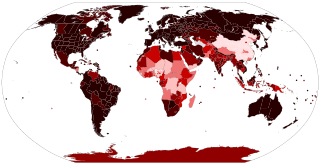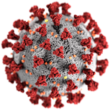
Botswana's healthcare system has been steadily improving and expanding its infrastructure to become more accessible. The infant mortality and maternal mortality ratios have been on a steady decline as a result of the improvements that have been made. The country's improving healthcare infrastructure has also been reflected in an increase of the average life expectancy from birth. Access to healthcare still has barriers for low income Batswana and those living in rural communities. The government of Botswana stresses primary healthcare with an emphasis on disease prevention and healthy living. Like many countries in Sub-Saharan Africa, Botswana is battling high rates of HIV/AIDS and infectious diseases. In 2013, about 25% of the population were infected with HIV/AIDS.

Women's health in India can be examined in terms of multiple indicators, which vary by geography, [socioeconomic] standing and culture. To adequately improve the health of women in India multiple dimensions of wellbeing must be analysed in relation to global health averages and also in comparison to men in India. Health is an important factor that contributes to human wellbeing and economic growth.

The 2019–20 coronavirus pandemic is an ongoing pandemic of coronavirus disease 2019 (COVID‑19) caused by severe acute respiratory syndrome coronavirus 2 (SARS‑CoV‑2). The outbreak was identified in Wuhan, China, in December 2019. The World Health Organization declared the outbreak a Public Health Emergency of International Concern on 30 January, and a pandemic on 11 March. As of 3 May 2020, more than 3.46 million cases of COVID-19 have been reported in 187 countries and territories, resulting in more than 244,000 deaths. More than 1.11 million people have recovered.

A coronavirus disease, coronavirus respiratory syndrome, coronavirus pneumonia, coronavirus flu, or any other variant, is a disease caused by members of the coronavirus (CoV) family.

Coronavirus disease 2019 (COVID-19) is an infectious disease caused by severe acute respiratory syndrome coronavirus 2 (SARS-CoV-2). The disease was first identified in December 2019 in Wuhan, the capital of China's Hubei province, and has since spread globally, resulting in the ongoing 2019–20 coronavirus pandemic. As of 3 May 2020, more than 3.46 million cases have been reported across 187 countries and territories, resulting in more than 244,000 deaths. More than 1.11 million people have recovered.

Neil Morris Ferguson is a British epidemiologist and professor of mathematical biology, who specialises in the patterns of spread of infectious disease in humans and animals. He is the director of the Abdul Latif Jameel Institute for Disease and Emergency Analytics (J-IDEA), head of the Department of Infectious Disease Epidemiology in the School of Public Health and Vice-Dean for Academic Development in the Faculty of Medicine, all at Imperial College, London.

The 2019–20 coronavirus pandemic was confirmed to have reached Bahrain in February 2020.

A COVID-19 vaccine is a hypothetical vaccine against coronavirus disease 2019 (COVID‑19). Although no vaccine has completed clinical trials, there are multiple attempts in progress to develop such a vaccine. In late February 2020, the World Health Organization (WHO) said it did not expect a vaccine against severe acute respiratory syndrome coronavirus 2 (SARS-CoV-2), the causative virus, to become available in less than 18 months. The Coalition for Epidemic Preparedness Innovations (CEPI) – which is organizing a US$2 billion worldwide fund for rapid investment and development of vaccine candidates – indicated in April that a vaccine may be available under emergency use protocols in less than 12 months or by early 2021.
Syra Madad is American pathogen preparedness expert. Madad is the Senior Director of the System-wide Special Pathogens Program at NYC Health + Hospitals where she is oversees New York City's response to the Coronavirus disease 2019 pandemic in the city's 11 public hospitals. She was featured in the Netflix documentary series Pandemic: How to Prevent an Outbreak.
Michael Joseph Ryan is an Irish former trauma surgeon and epidemiologist specialising in infectious disease and public health. He is Executive Director of the World Health Organization's Health Emergencies Programme where he leads the team responsible for the international containment and treatment of COVID-19. Ryan has held leadership positions and has worked on various outbreak response teams in the field to eradicate the spread of diseases including bacillary dysentery, cholera, Crimean–Congo hemorrhagic fever, Ebola, Marburg virus disease, measles, meningitis, relapsing fever, Rift Valley fever, SARS, and Shigellosis.

Flattening the curve is a public health strategy introduced during the 2019–20 COVID-19 pandemic. The curve being flattened is the epidemic curve, a visual representation of the number of infected people needing health care over time. During an epidemic, a health care system can break down when the number of people infected exceeds the capability of the health care system to take care of them. Flattening the curve means slowing the spread of the epidemic so that the peak number of people requiring care at a time is reduced, and the health care system is not overwhelmed. Flattening the curve relies on mitigation techniques such as social distancing.

The effect of COVID-19 infection on pregnancy is not completely known because of the lack of reliable data.
Maria D. Van Kerkhove is an American infectious disease epidemiologist. With a background in high threat pathogens, Van Kerkhove specializes in emerging infectious diseases and is based in the Health Emergencies Program at the World Health Organization (WHO). She is the technical lead of COVID-19 response and the head of emerging diseases and zoonosis unit at WHO.

The 2019–20 coronavirus pandemic has affected the usage of social media by the world's general population, celebrities, world leaders, and professionals. Social networking services have been used to spread information, and to find humour and distraction from the pandemic via Internet memes.
Alexandra Phelan is a faculty member of the Center for Global Health Science and Security at Georgetown University School of Medicine and an Assistant Professor in the Department of Microbiology and Immunology at Georgetown University. She specializes in legal and policy issues that are related to emerging and reemerging infectious diseases, as well as health threats posed by climate change.

Amid the 2019–20 coronavirus pandemic, anti-abortion government officials in several American states enacted or attempted to enact restrictions on abortion, characterizing it as a non-essential procedure that can be suspended during the medical emergency. The orders have led to several legal challenges and criticism by human rights groups and several national medical organizations, including the American Medical Association. Legal challenges on behalf of abortion providers, many of which are represented by the American Civil Liberties Union and Planned Parenthood, have successfully stopped some of the orders on a temporary basis, though bans in several states have not been challenged.

The World Health Organization is a leading organization involved in the global coordination for mitigating the 2019-20 coronavirus pandemic. On 5 January 2020, the WHO notified the world about "pneumonia of unknown cause" from China and subsequently followed up with investigating the disease. On 20 January, the WHO confirmed human-to-human transmission of the disease. On 30 January, the WHO declared the outbreak a Public Health Emergency of International Concern and warned all countries to prepare. On 11 March, WHO said that the outbreak constituted a pandemic. The WHO has spearheaded several initiatives like COVID-19 Solidarity Response Fund for fundraising for the pandemic and Solidarity Trial for investigating potential treatment options for the disease. The WHO has been criticized by various observers as reacting too slowly, or of being unable to criticize China.

Amid the 2019–20 coronavirus pandemic many countries have reported an increase in domestic violence and intimate partner violence. United Nations Secretary-General António Guterres, noting the "horrifying global surge" has called for a domestic violence "ceasefire". The European Parliament came out with a press release addressing the issue writing "we won’t leave Europe's women alone" and asked member states to increase support to domestic violence victims during pandemic.
Eleni Nastouli is a Consultant Clinical Virologist at University College London Hospitals NHS Foundation Trust (UCLH) and Great Ormond Street Hospital. At UCLH Nastouli leads the Advanced Pathogen Diagnostics Unit, where she develops technologies for genome sequencing as well as studying how viruses are transmitted around hospitals. During the 2019–20 coronavirus pandemic Nastouli led an investigation into infection rates amongst healthcare workers.

Coronavirus disease 2019 has a low case fatality rate, but the actual numbers of deaths are considerable given the huge scale of the pandemic. As of 26 April 2020, over 200,000 people have died due to COVID-19, while over 870,000 people have recovered. Deaths are more common in those aged over 60 years and those with co-morbidities. Most people affected with the disease recover without any particular treatment. Poor outcomes and mortality are associated with old age, profound disabilities and frailty.









